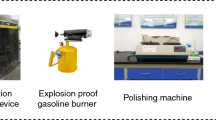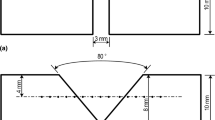Abstract
Copper-clad aluminum wires have a high risk of electrical fire, and welding marks are easily affected by factors such as high temperature and fire water in the actual fire. To accurately identify the overcurrent fault, an electrical fault simulator was used in this study to simulate the overcurrent fault condition of a copper-clad aluminum at a current of 52.5–105 A. Then the microstructure characteristics such as metallographic structure, welding hole elements, and so on under different treatment methods were also analyzed using the metallographic microscope and SEM/EDS. The results of the study are summarized as follows: (1) under the method of natural cooling, the metallographic structure of the welding mark were mainly columnar crystals and dendritic crystals with a few holes in it. And we found that the maximum particle size and average particle size have a quadratic function relationship with the current value; (2) under the water-cooling method, the welding mark was mainly columnar crystals with a large number of holes in them. At a current of 75 A, the welding mark holes consisted of Al and Cu elements, while at the rest of the current value, they consisted of Al, Cu, and O elements; (3) when the temperature was raised to 450 °C, the welding trace has different elements at different currents. At the temperature of 650 °C, a large number of equiaxed crystals appeared in the welding trace, with a few holes in which at a current at 105 A only. Our study has provided a basis for the investigation of electrical fire accidents and the technical identification of the causes.

















Similar content being viewed by others
References
Xin J, Huang CF. Fire risk assessment of residential buildings based on fire statistics from China. Fire Technol. 2014;50:1147–61.
Zhi JY, Shuang SC, Jun D, Xue XX, Wei FW. Microstructural characteristics of arc beads with overcurrent fault in the fire scene. Materials. 2020;13:4521.
Babrauskas V. SFPE handbook of fire protection engineering (fifth edition): electrical fires. Dordrecht: Springer; 2016. p. 47–63.
Babrauskas V. Research on electrical fires: the state of the art. In: Fire safety science-proceedings of the ninth international symposium, USA; 2008. p. 3–18.
Babrauskas V. How do electrical wiring faults lead to structure ignitions. London: Fire and Materials; 2001. p. 39–51.
Su YJ, Liu XH, Huang HY, et al. Effects of processing parameters on the fabrication of copper cladding aluminum rods by horizontal core-filling continuous casting. Metall Mater Trans B. 2011;42(1):104–13.
Babrauskas V. How do electrical wiring faults lead to structure ignitions. Fire Mater. 2001;52:39–49.
NFPA921. Guide for fire and explosion investigations. Quincy: National Fire Protection Association; 2017.
Cai Z, Shi L. Experimental study on microstructure of overcurrent fault of copper conductor. J Phys: Conf Ser. 2021;1885(3):032062.
Yu Z, Chen S, Deng J, et al. Microstructural characteristics of arc beads with overcurrent fault in the fire scene. Materials. 2020;13(20):4521.
Wright SA, Loud JD, Blanchard RA. Globules and beads: what do they indicate about small-diameter copper conductors that have been through a fire. Fire Technol. 2015;51(5):1051–70.
Yang LI, Yang LI, Jing J, et al. Macroscopic and microscopic characteristics of primary short-circuiting trace of copper conductor. Fire Sci Technol. 2019;38(03):313–317.
Xu X, Yu Z, Li Y, et al. Microstructural study of arc beads in aluminum alloy wires with an overcurrent fault. Materials. 2021;14(15):4133.
Liu KH, Shih YH, et al. Microstructural study on molten marks of fire-causing copper wires. Materials. 2015;8:3776–90.
Zhu J, Yu G, Liu T, et al. Application of copper cladding aluminum composites in UHV portable earthing and short-circuiting wires. MATEC web of conferences. EDP Sci. 2018;160:1004.
Babrauskas V. Arc beads from fires: can ‘Cause’ beads be distinguished from ‘Victim’ beads by physical or chemical testing. J Fire Prot Eng. 2004;14:125–47.
Jin-bao Z, Yi-kun X, Guang-ying Z, et al. Microstructure characteristics of overcurrent melt trace of aluminum alloy wire. Fire Sci Technol. 2021;40(6):932.
Zhang J, Chen T, Su G, et al. Microstructure and component analysis of glowing contacts in electrical fire investigation. Eng Fail Anal. 2022;140:106539.
Xu N, Ding N, Liu L, et al. Microscopic characteristics of copper wires with short-circuit molten marks in electrical fire. Mater Test. 2023;65(6):844–54.
Acknowledgements
This work was supported by the National Key R&D Plan (2021YFE0105000), National Key R&D Plan (2023YFC3009800), National Natural Science Foundation (52074213), Shaanxi Key R&D Plan (2021SF-472, 2022QCY-LL-70), Shaanxi Qin Chuangyuan "Scientists+Engineers" Team Construction (2023KXJ-052).
Author information
Authors and Affiliations
Contributions
WW contributed to Article ideas and experimental tests, and wrote the paper. XJ contributed to Further deeply discussed experimental ideas. FZ contributed to Completed the data testing. XZ contributed to Completed the data analysis. XG contributed to Improved analysis methods. DH contributed to Review and editing. LW contributed to Check the final version of the paper to be published.
Corresponding authors
Ethics declarations
Conflict of interest
The authors declare that they have no known competing financial interests or personal relationships that could have appeared to influence the work reported in this paper.
Additional information
Publisher's Note
Springer Nature remains neutral with regard to jurisdictional claims in published maps and institutional affiliations.
Rights and permissions
Springer Nature or its licensor (e.g. a society or other partner) holds exclusive rights to this article under a publishing agreement with the author(s) or other rightsholder(s); author self-archiving of the accepted manuscript version of this article is solely governed by the terms of such publishing agreement and applicable law.
About this article
Cite this article
Wang, W., Ji, X., Zhang, F. et al. Study on the microstructure characteristics of melting marks in copper-clad aluminum wires under overcurrent faults. J Therm Anal Calorim 149, 345–357 (2024). https://doi.org/10.1007/s10973-023-12681-5
Received:
Accepted:
Published:
Issue Date:
DOI: https://doi.org/10.1007/s10973-023-12681-5




